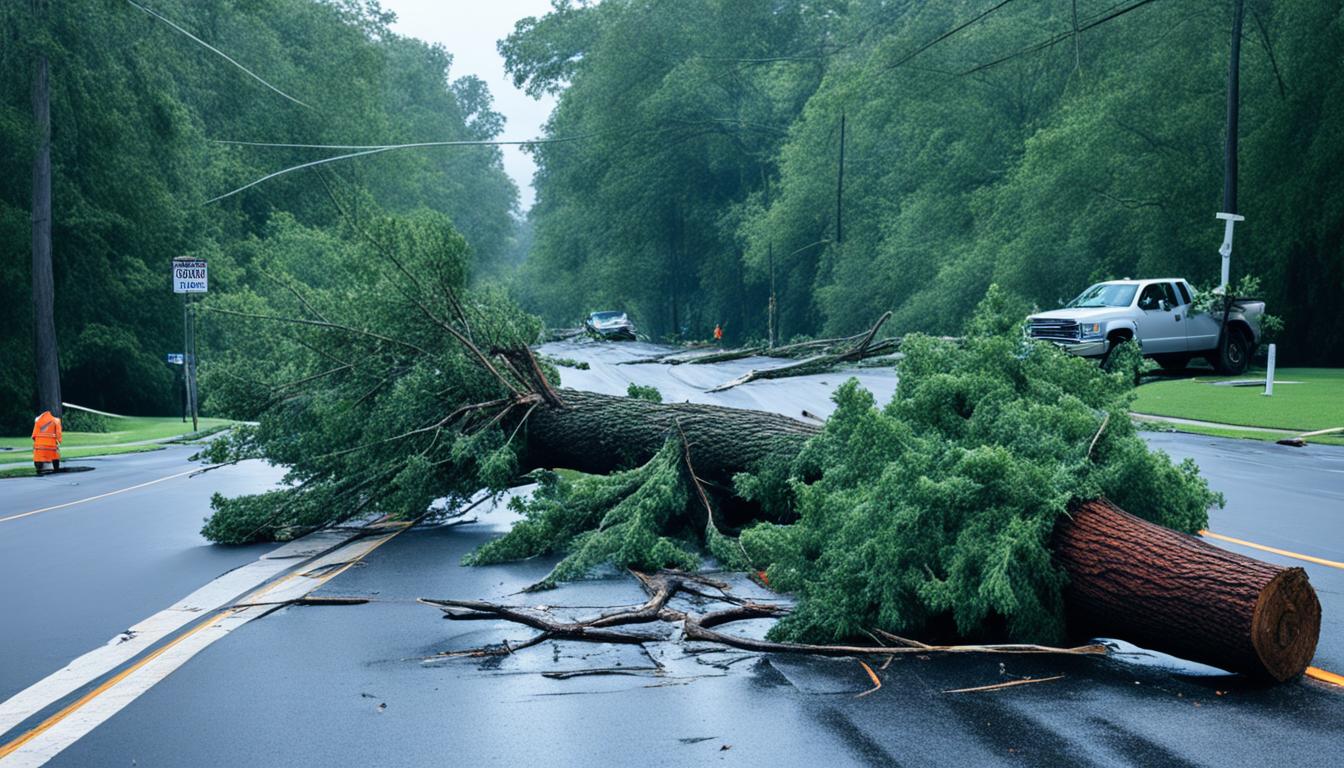Did you know that severe weather events cause an estimated $100 billion in damages in the United States every year? Storms have the potential to unleash a destructive force that can wreak havoc on our surroundings, leaving a trail of destruction in their wake. From property damage to environmental devastation, the impact of storms can be immense.
Key Takeaways:
- Severe weather events in the US result in approximately $100 billion in damages annually.
- Storms can cause significant property destruction and have a lasting impact on the environment.
- Understanding the various types of storm damage is crucial for preparedness and response.
- Proper planning and response measures can help minimize the impact of storms and protect lives and property.
- Stay informed and take proactive steps to ensure storm damage prevention and safety.
The Devastating Force of Severe Thunderstorms
Severe thunderstorms are a powerful force of nature that can cause widespread damage. These intense weather systems are characterized by strong winds, heavy rain, lightning, and sometimes hail. Severe thunderstorms can develop rapidly, catching people off guard and leaving a wake of destruction in their path.
The formation of severe thunderstorms generally occurs when warm, moist air rises rapidly, creating instability in the atmosphere. This instability leads to the rapid development of cumulonimbus clouds, which are the signature clouds of severe thunderstorms. These clouds can reach high altitudes and have the potential to produce severe weather phenomena.
One of the most significant dangers of severe thunderstorms is the potential for strong and damaging winds. These winds can exceed 50 miles per hour and have the power to uproot trees, damage buildings, and cause power outages. The destructive force of the winds can be intensified by the presence of a downburst or a tornado, which are often associated with severe thunderstorms.
Another major threat posed by severe thunderstorms is heavy rainfall. These storms can unleash torrential downpours that lead to flash flooding. The rapid accumulation of water can overwhelm drainage systems and cause rivers, streams, and low-lying areas to overflow. The resulting flooding can damage homes, infrastructure, and vehicles.
In addition to strong winds and heavy rain, severe thunderstorms are also known for their frequent lightning activity. These lightning strikes can pose a significant risk to both buildings and people. Lightning can cause fires, damage electrical systems, and, in worst-case scenarios, lead to injuries and fatalities.
Lastly, severe thunderstorms have the potential to produce large hailstones. These ice projectiles are formed when raindrops are carried upward within the storm’s updrafts and freeze into layers of ice. Hail can range in size from small pellets to golf balls and even larger. The impact of hailstones can cause significant damage to structures, vehicles, and crops.
Overall, severe thunderstorms are a formidable force of nature that must be taken seriously. Their destructive capabilities include strong winds, heavy rain, lightning, and hail. Understanding the characteristics and dangers of severe thunderstorms is essential for staying safe and minimizing the potential damage caused by these destructive storms.
Lightning Strikes: Electrical Havoc and Wildfires
During thunderstorms, lightning strikes pose a significant danger, causing not only electrical havoc but also potentially igniting devastating wildfires. The powerful discharge of electricity from a lightning bolt can have catastrophic consequences, impacting both human-made structures and the natural environment.
When lightning strikes a building or infrastructure, it can damage electrical systems, leading to fires, power outages, and even structural collapse. The intense heat generated by a lightning strike can also cause materials to ignite, further exacerbating the risk of fire.
However, the threat of lightning-induced wildfires is perhaps one of the most destructive and widespread consequences. Lightning strikes can ignite dry vegetation, especially during drought conditions, rapidly spreading the fire and endangering homes, wildlife, and natural resources.
To mitigate the risks of lightning damage and wildfires, various preventative measures can be implemented. These include the installation of lightning protection systems on buildings, which help safely divert the electrical discharge into the ground, reducing the likelihood of damage.
Furthermore, proactive measures such as clearing brush and maintaining defensible space around homes and structures can help minimize the potential fuel for wildfires sparked by lightning. Additionally, maintaining awareness of lightning risks during thunderstorms and following safety protocols, such as seeking shelter indoors and avoiding high-risk outdoor activities, can help protect individuals from lightning-related dangers.
In summary, lightning strikes during thunderstorms present a dual threat: electrical havoc and the potential for devastating wildfires. By taking proactive measures to protect buildings, infrastructure, and natural areas, as well as following safety protocols during thunderstorms, the risks associated with lightning strikes can be mitigated, reducing the potential for both electrical damage and the ignition of destructive wildfires.
Tornadoes: The Twisting Terror of Storms
Tornadoes are one of the most destructive forces of nature, capable of causing widespread devastation. These violent and rapidly rotating columns of air can appear within severe thunderstorms and have the power to flatten buildings, uproot trees, and hurl debris through the air with incredible force.
In terms of their formation, tornadoes are typically born from the interaction of warm, moist air from the Gulf of Mexico and cooler, drier air from the Rockies. When these air masses collide, they create an unstable atmosphere, setting the stage for the development of tornadoes.
Tornadoes vary in size and intensity, with some reaching wind speeds of over 300 miles per hour. The Enhanced Fujita Scale is used to classify tornadoes based on the damage they cause, ranging from EF0 (light damage) to EF5 (catastrophic damage).
The damage inflicted by tornadoes is often devastating. These destructive storms can level entire neighborhoods, causing structural collapses, tearing off roofs, and shattering windows. Large objects become dangerous projectiles, posing a significant risk to life and property.
To stay safe during a tornado, it is crucial to have a plan in place. Seek shelter in the lowest level of a sturdy building, preferably a basement or storm cellar. If a basement is not available, find an interior room or hallway away from windows. Protect yourself by covering your head with a mattress or heavy blankets.
Additionally, staying informed and being aware of tornado warnings and watches are key to tornado safety. Pay attention to weather alerts, listen to local authorities, and have a reliable source of information, such as a weather radio or a smartphone app.
Remember, tornadoes are unpredictable and can strike with little warning. Being prepared and knowing how to react can make a significant difference in mitigating the risks associated with these twisting terrors of storms.
What Damage Can Storms Do?
When storms unleash their fury, they can wreak havoc on both natural landscapes and man-made structures. The destructive power of storms is evident in the extensive damage they can cause. From winds that can tear roofs off buildings to heavy rainfall that leads to flooding, storms can leave a trail of destruction in their wake.
One of the most common types of storm damage is structural damage to buildings. Strong winds can bend, break, or completely remove roofing materials, leaving homes and businesses exposed to the elements. Falling trees and debris can also cause significant damage to the exterior of structures, compromising their integrity.
In addition to structural damage, storms can cause extensive flooding. Torrential rainfall can overwhelm drainages systems and cause water to accumulate rapidly. This can lead to water entering buildings, damaging foundations, walls, and belongings. Floodwaters can also erode soil, posing a threat to infrastructure such as roads, bridges, and utility lines.
Storms can also cause damage to infrastructure beyond buildings. High winds can uproot trees, damage power lines, and disrupt communication networks. This can result in power outages, loss of internet and phone services, and transportation disruptions.
Real-life scenarios illustrate the destructive potential of storm damage. Coastal areas frequently experience storm surge during hurricanes, which can cause significant damage to coastal structures and erosion of beaches. In tornado-prone regions, entire neighborhoods can be decimated, with debris scattered for miles.
The types of storm damage are diverse, and their consequences can be devastating. Understanding the potential damage that storms can cause is key to preparedness and implementing measures to mitigate their impact.
Thunderstorms and the Hazard of High Winds Over Water
Thunderstorms that occur over bodies of water pose unique hazards, particularly due to the high winds they produce. These thunderstorms, known as thunderstorms over water, can create dangerous conditions for boaters, beachgoers, and anyone near the shoreline. The combination of strong winds and the open expanse of water amplifies the potential risks and makes it essential for individuals to be aware of the marine weather hazards.
When thunderstorms develop over water, they can generate high winds that are capable of causing significant damage. These powerful gusts can create rough seas, leading to hazardous conditions for boaters and watercraft. The strong winds can make it challenging to maneuver vessels and increase the risk of capsizing or collisions. Boaters should closely monitor weather forecasts and, if necessary, seek safe harbor well in advance to avoid being caught in the path of an approaching thunderstorm.
In addition to the high winds, marine weather hazards associated with thunderstorms over water include the potential for water spouts and damaging waves. Water spouts are tornado-like columns of spinning water that form over lakes, oceans, or rivers. They can pose a significant threat to boaters and should be avoided or navigated around with caution. Damaging waves generated by thunderstorms can also result in beach erosion, coastal flooding, and property damage along the shoreline.
Beachgoers should exercise caution during thunderstorms over water and follow any advisories or warnings issued by local authorities. It is important to seek shelter in a safe location away from the water and avoid standing on exposed beaches, piers, or other areas vulnerable to high winds and rough surf. Swimming or engaging in water activities during thunderstorms is extremely dangerous and should be avoided at all costs.
In summary, thunderstorms over water pose a unique set of hazards due to the high winds they produce. Whether on a boat or at the beach, it is crucial to prioritize safety and stay informed about marine weather conditions. Being aware of the risks and taking appropriate precautions can help minimize the dangers associated with thunderstorms over water and ensure the well-being of individuals and property.
Convection: The Engine Behind Storm Destruction
Convection plays a crucial role in the development and intensity of storms. Understanding how convection works is key to predicting and preparing for severe weather events.
Convection occurs when warm air rises in the atmosphere due to temperature differences. As the warm air rises, it cools and condenses, forming clouds. This process releases latent heat, which further fuels the convection process and contributes to storm development.
Atmospheric instability is a key factor in promoting convection. When the air near the surface is warmer and more buoyant than the air above it, it becomes unstable and prone to vertical motion. This instability can be caused by factors such as differential heating, frontal boundaries, or moisture availability.
The updrafts generated by convection lead to the development of storm clouds and vertical air movement within these clouds. Updrafts can carry moisture and condensation into the upper levels of the storm, where it can freeze and form hail. As the storm continues to develop, the updrafts strengthen, leading to the formation of thunderstorms with heavy rain, lightning, and strong winds.
The destructive potential of convection is evident in severe thunderstorms and tornadoes. These intense weather phenomena are often fueled by convection that is enhanced by factors such as high levels of atmospheric instability and wind shear. The combination of these elements can lead to the formation of powerful updrafts and rotating mesocyclones, which can result in violent tornadoes with devastating consequences.
Understanding and monitoring convection is essential for meteorologists and storm observers to provide accurate forecasts and warnings. By studying the atmospheric conditions conducive to convection, scientists can gain insights into storm development, track storm movements, and issue timely alerts to communities at risk.
As our understanding of convection improves, so does our ability to anticipate and prepare for the destructive forces of severe weather. By staying informed about atmospheric instability and other indicators of convection, individuals and communities can take necessary precautions to protect life and property.
Lifespan of Thunderstorms and Potential for Damage
Thunderstorms have a lifespan that can range from just a few minutes to several hours. Understanding the stages of a thunderstorm’s lifespan is crucial in assessing its potential for causing damage. Factors such as storm duration and intensity can significantly impact the destructive potential of a thunderstorm.
During the early stage of a thunderstorm, known as the cumulus stage, warm, moist air rises rapidly, forming towering cumulus clouds. As the warm air continues to rise, it begins to cool, and condensation occurs, resulting in the formation of raindrops and the onset of precipitation. At this stage, the thunderstorm is still building and may not pose an immediate threat.
In the mature stage, the thunderstorm reaches its peak intensity. Updrafts and downdrafts within the storm system promote the development of heavy rain, lightning, and strong winds. The potential for damage is highest during this stage, as the storm is capable of producing gusty winds, large hail, and dangerous lightning strikes.
As the thunderstorm progresses into the dissipating stage, the updraft weakens, and the storm begins to weaken. Rainfall becomes less intense, and the thunder and lightning activity diminish. Although the storm is in the process of dissipating, it can still produce gusty winds, lightning, and localized heavy rainfall, potentially causing further damage.
Several factors can influence the lifespan and potential for damage of a thunderstorm. Environmental conditions such as atmospheric instability, high moisture content, and a strong wind shear can contribute to the longevity of a thunderstorm and enhance its destructive capabilities. Additionally, interactions with other storm systems or geographic features, such as mountains or bodies of water, can prolong and intensify a thunderstorm, increasing its damage potential.
Understanding the lifespan and potential impacts of thunderstorms is essential for preparedness and response. By staying informed about weather forecasts and heeding warnings from meteorological authorities, individuals and communities can take appropriate measures to protect themselves and minimize the potential damage caused by thunderstorms.
Preparedness and Response to Weather Hazards
In the face of severe weather, being prepared and knowing how to respond are essential for minimizing damage and ensuring personal safety. By taking proactive measures and developing an emergency plan, individuals and communities can effectively navigate through storm events. Here are some practical tips and advice for storm preparedness:
- Create an emergency plan: Develop a comprehensive plan that includes evacuation routes, designated meeting spots, and contact information for emergency services. Practice the plan with household members to ensure everyone knows what to do in case of a storm.
- Secure property: Safeguard your home by reinforcing doors and windows, trimming trees near buildings, and securing loose objects that could become projectiles in high winds.
- Stock up on supplies: Build an emergency kit that includes essential items such as non-perishable food, water, medications, flashlights, batteries, and a first aid kit. Make sure to have enough supplies to last for at least 72 hours.
- Stay informed: Keep track of weather updates and warnings through reliable sources such as the National Weather Service (NWS) or local meteorological services. Follow their instructions and heed any evacuation orders or severe weather advisories.
- Seek shelter: If a storm is approaching, seek shelter in a safe location such as a basement, storm cellar, or a small, windowless interior room on the lowest level of your home.
- Have a communication plan: Establish a communication system with family members or neighbors to stay connected during a storm. Consider using walkie-talkies, mobile apps, or a designated contact person outside the affected area.
- Be cautious after the storm: Even after a storm has passed, be mindful of hazards such as downed power lines, water damage, or weakened structures. Avoid driving through floodwaters and report any gas leaks or electrical hazards to the relevant authorities.
By following these storm preparedness guidelines, individuals and communities can improve their resilience and minimize the impact of severe weather events. Remember, a proactive approach to emergency planning and response can make all the difference in staying safe during stormy times.
Conclusion
In conclusion, storms pose a significant threat to both property and human life. However, by implementing effective storm damage prevention strategies and prioritizing storm safety measures, the impact of these natural disasters can be mitigated.
Throughout this article, we explored the various types of storm damage, including property destruction, environmental aftermath, and the risks to personal safety. We learned about the devastating force of severe thunderstorms and the havoc caused by lightning strikes, which can result in electrical damage and wildfires.
Tornadoes were also discussed, highlighting their destructive power and the importance of tornado safety. Additionally, we examined the hazards of thunderstorms over bodies of water and the vital role of convection in storm development and intensification.
By emphasizing storm preparedness, including creating an emergency plan and staying informed during severe weather events, individuals can take an active role in minimizing storm damage. Remember, storm damage prevention and safety should always be a top priority to safeguard lives and protect property.
FAQ
What types of damage can storms cause?
Storms have the potential to cause significant damage to both property and the environment. They can lead to property destruction, environmental aftermath, and impact human life.
What are severe thunderstorms?
Severe thunderstorms are a powerful force of nature that can cause widespread damage. They are characterized by their formation, intensity, and the types of damage they can cause.
What are the dangers of lightning during thunderstorms?
Lightning strikes are a common occurrence during thunderstorms and can have devastating consequences. They pose a risk of electrical damage to buildings and infrastructure, as well as the potential for wildfires ignited by lightning strikes.
What makes tornadoes so destructive?
Tornadoes are one of the most destructive forces of nature. They can cause widespread devastation due to their formation, intensity, and the types of damage they can inflict. Safety measures and preparedness tips for tornadoes will also be discussed.
What types of damage can storms cause?
Storms can cause a wide range of damage, including structural damage to buildings, flooding, and damage to infrastructure. Examples of real-life scenarios where storm damage has occurred will also be provided.
What are the hazards of thunderstorms over water?
Thunderstorms that occur over bodies of water pose unique hazards due to the high winds they produce. The risks to boaters and beachgoers, as well as the potential for water spouts and damaging waves, will be discussed.
How does convection contribute to storm destruction?
Convection plays a crucial role in the development and intensity of storms. This section will explore how convection works, its role in storm formation and growth, and the atmospheric conditions that contribute to convection. The destructive potential of convection will also be discussed.
What is the lifespan of a thunderstorm and its potential for damage?
Thunderstorms have a lifespan that varies from a few minutes to several hours. This section will explain the stages of a thunderstorm’s lifespan and how they impact its potential for causing damage. Factors that can prolong or intensify a thunderstorm, as well as their potential impacts, will be discussed.
How can I prepare for storms and respond to severe weather?
Being prepared for storms and knowing how to respond to severe weather is crucial for minimizing damage and ensuring personal safety. This section will provide practical tips and advice for storm preparedness, including creating an emergency plan, securing property, and staying informed during severe weather events.







